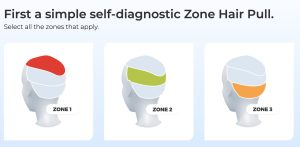
Dealing with postpartum hair loss can be really tough for new moms. Did you know it usually happens about three months after childbirth and can last up to six months? Our blog will help you understand why this happens and how you can manage it better.
Keep reading to find out more!
Key Takeaways
- Postpartum hair loss often starts about three months after childbirth and can last up to six months. It happens due to a drop in estrogen levels.
- Eating a balanced diet with iron, vitamin D, and protein can help reduce hair loss. Keeping hydrated is also important.
- Use gentle hair care practices like using volumizing shampoos and avoiding tight hairstyles or high heat settings on styling tools.
- Consult a doctor if your hair loss lasts longer than six months or if you notice severe bald spots or receding hairlines. This could be due to other health issues like thyroid disease.
- This phase is temporary, and with the right care, your hair should improve over time. Enjoy this period with your new baby while taking small steps for better hair health.
Causes and Symptoms of Postpartum Hair Loss
After childbirth, many women see a large amount of hair shedding. This is due to hormone changes that impact the hair growth cycle.
Hormonal changes and their impacts
Hormonal changes play a big role in postpartum hair loss. During pregnancy, estrogen levels rise and keep most of the hair in the anagen phase or growth phase, which makes hair appear thicker.
After childbirth, these estrogen levels drop sharply. This causes many hairs to enter the telogen phase or shedding phase all at once.
The sudden change results in noticeable hair shedding. Many women see clumps of hair clogging their shower drains and covering floors. This phenomenon is called telogen effluvium. It usually happens around 3-4 months after giving birth and can feel distressing but is typically temporary as the body’s hormone levels balance out over time.
Hair grows from follicles in the scalp and has three phases: Anagen Phase, Catagen Phase, Telogen Phase.
Identifying excessive hair loss
Postpartum hair loss often shows up a few months after childbirth. A key sign is finding more loose hair on your brush, pillow, or shower floor. Women may notice shedding up to 300 hairs each day during this period.
If you see bald spots or thinning areas that don’t improve over time, it’s important to pay attention.
This condition is called telogen effluvium and happens because of pregnancy hormones changing after delivery. Look out for these signs if you are breastfeeding or using certain hair products like perms and curling irons.
If the problem persists, move on to effective treatments for postpartum hair loss in the next section.
Effective Treatments for Postpartum Hair Loss
Taking care of your hair after having a baby can help reduce hair loss. Eating the right foods and using gentler products are good steps to start.
Nutritional adjustments and supplements
Hair loss after childbirth is common. Eating right and taking supplements can help.
- Maintain a Nutrient-Rich Diet:
- Include foods like carrots, spinach, and sweet potatoes.
- These foods have beta carotene which supports hair health.
- Continue Prenatal Vitamins:
- Keep taking prenatal vitamins even after birth.
- They provide essential nutrients for hair regrowth and fullness.
- Iron-Rich Foods:
- Boost iron intake by eating lean meats, beans, and leafy greens.
- Iron deficiency can cause hair loss.
- Vitamin D Supplements:
- Take vitamin D to promote healthy hair follicles.
- Most people need a supplement due to low sunlight exposure.
- Hydrate Well:
- Drink plenty of water daily.
- Hydration supports overall health including your hair shaft.
- Protein Intake:
- Eat eggs, fish, and dairy products for protein.
- Protein is vital for strong hair growth.
- Consult a Healthcare Provider:
- Ask about suitable dietary supplements if necessary.
- Professional advice ensures proper nutrition without overuse of vitamins.
- Avoid Extreme Diets:
- Steer clear of crash diets; they can worsen hair loss.
Gentle hair care and suitable products
Taking care of your hair gently can help reduce postpartum hair loss. Use suitable products to keep your hair looking full and healthy.
- Use Volumizing Shampoos
Opt for shampoos designed to add body to your hair. These products make hair look fuller without weighing it down. - Choose Lightweight Conditioners
Apply lightweight conditioners instead of heavy ones. This prevents your hair from becoming limp and lifeless. - Wash Hair Gently
Handle your mane carefully while washing. Avoid tugging or pulling on it too hard. - Lower Heat Settings
Use lower heat settings on styling tools like blow dryers, flat irons, or curling irons. High heat can cause more damage and breakage. - Avoid Tight Hairstyles
Refrain from wearing tight ponytails or braids that pull on the scalp. They can increase tension and lead to more loss of strands. - Try Shorter Hairstyles
Consider getting a shorter haircut for easier maintenance and a thicker appearance. Shorter styles often make thinning areas less noticeable. - Avoid Over-Washing Hair
Shampooing daily can strip natural oils from your scalp, leading to dry and brittle locks. - Use Dry Shampoos
Dry shampoos can be helpful in keeping the scalp fresh between washes without washing away essential oils.
Effective treatments are crucial for managing postpartum hair loss successfully.
When to Consult a Healthcare Provider
If your hair loss seems extreme or lasts longer than six months, see a doctor. They can check for issues like thyroid disease or nutritional deficiencies.
Recognizing signs that require professional advice
Hair loss that continues for more than six months after childbirth might need professional advice. Significant hair shedding could signal issues such as iron deficiency or thyroid disorders.
These conditions often require a doctor’s evaluation and specific treatment.
If your hair does not return to normal within a year, consult a healthcare provider. Persistent thinning or no signs of regrowth also indicate the need for expert help. Immediate action is crucial if you notice symptoms like severe balding or receding hairline.
Always consider medical history and physical exams in diagnosing prolonged hair loss issues.
Conclusion
You can manage postpartum hair loss with the right tips and treatments. Simple changes in diet and gentle hair care help. If your hair loss lasts more than six months, talk to a healthcare provider.
This phase is temporary, and soon you should see improvement in your hair’s fullness. Stay positive, take care of yourself, and enjoy time with your baby!

FAQs
1. What causes postpartum hair loss?
Postpartum hair loss is caused by hormonal changes after pregnancy and childbirth, including shifts in progesterone and prolactin levels affecting the hair cycle.
2. How can I treat postpartum hair loss?
You can manage postpartum hairloss with treatments like a healthy diet, relaxation techniques, consulting a dermatologist for a proper diagnosis, or using weaves and hair extensions to add fullness.
3. Should I consult a hairstylist for my thinning hair?
Yes, visiting a hairstylist can help you find styles that enhance your remaining hair’s appearance while providing tips on managing thinning spots effectively.
4. Is it safe to use weaves or extensions while breast-feeding?
Yes, using weaves or extensions is generally safe during breastfeeding as they do not interfere with breast-feeding but always check with your healthcare provider if you have concerns.
5. Can stress from childbirth affect my hair health?
Yes! Stress from pregnancy and childbirth can affect your overall well-being including causing issues like the rare condition of “hair tourniquet,” so practicing relaxation methods helps maintain better health post-pregnancy.



